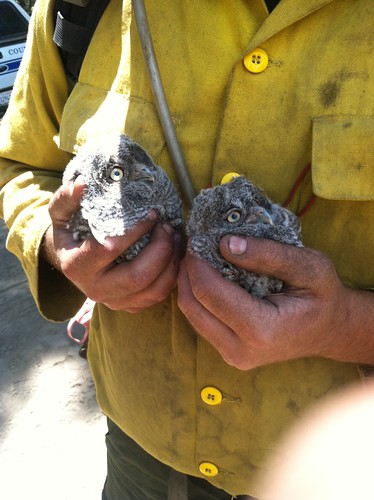
Nick Gauthier, a firefighter with Stanislaus National Forest Engine 12, holds two baby owls that fell out of a tree during the Carstens Fire on the Sierra National Forest. (U.S. Forest Service photo)
As the flames from the recent Carstens Fire in the Sierra National Forest approached, two baby Western screech owls huddled abandoned in a nest.
Then, without warning, the tree that was their home came crashing down to the ground. Firefighters working to contain the quickly-spreading fire had cut down the tree to build a fire control line. Too young to fly, the baby owls tumbled to the ground and onto a roadway.
Firefighter Nick Gauthier and a fellow firefighter saw the owls and gently scooped them up and placed them back into the hollow of the tree for protection. As part of the fire control line, the tree – and the owls – would be safe from immediate danger.
Firefighters called in Francey Blaugrund, the fire’s resources advisor, who then summoned Anae Otto, wildlife biologist for the Sierra National Forest’s Bass Lake Ranger District, to retrieve the owls. Otto immediately jumped in her car to make the 2½-hour drive to the site. When she arrived, Otto found the owls, which she estimates were two to three weeks old, disoriented and dehydrated, but not burned.
Otto wrapped the owls in a towel, placed them in a cardboard box and drove them to her house. Throughout the night, she hand-fed them a rehydration solution of water, sugar and salt, a task she had to complete every 15 minutes for the first two hours. She followed that up with a tasty meal of nightcrawlers. The older owlet was actively “beak clacking” and ate solid food that night. But the younger owl was lethargic and would not eat until the following morning, when he had regained some of his strength from the rest and the rehydration solution.
“My heart was racing when I received the report of owls on the ground in the Carstens Fire,” Otto said. “I was concerned because there were no details as to how old they were, how long they had been exposed, etc. I was relieved to find the owlets alive and in fair condition.
“So much of my daily work deals with habitat protection. It was very rewarding to provide direct assistance to an animal in need.”
Later the following morning, Otto took the owlets to Terri Williams, a local wildlife rehabber in Coarsegold, Calif., who volunteers for the Fresno Wildlife Rescue and Rehabilitation Service. Otto and Williams named the owlets “Puff” and “Fluff” because the older owlet puffs up at feeding time, and their downy feathers give them a fluffy look.
Puff and Fluff are eating on their own and have acquired quite a hearty appetite, each downing 25 crickets, two mice and a chick every day, Williams reported. The owls will stay with Williams until they are ready to fly in several weeks. They’ll then be released in the unburned area outside of the fire perimeter near where they were found.
Western screech owls, roughly 7-10 inches tall as adults, are common on the Sierra National Forest, and throughout much of the western United States. The owls, which also can be found in urban and suburban parks and residential areas, feed mainly on small rodents and insects. Their sounds are unique, sometimes referred to as a bouncing ball series of low whistles.
No comments:
Post a Comment
Note: Only a member of this blog may post a comment.